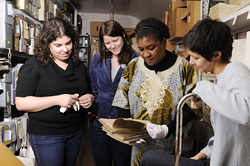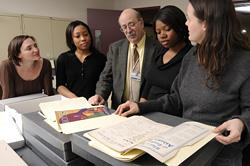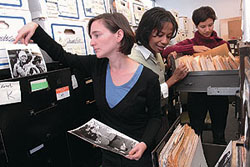Our Partner Repositories
DuSable Museum of African American History

Founded in 1961 and the oldest institution of its kind in the U.S., the DuSable Museum of African American History mounts exhibits that interpret African American and African history for the general public.
The exhibition holdings range from paintings by master African American artists, a collection of over 2,000 African artifacts and a range of objects from the early 1800's to the present. There is an extensive photographic collection as well as costumes, works on paper, and sculpture.
The Archives/Research Collection contains the personal papers of notable African Americans, rare books, periodicals, manuscripts, political ephemera, oral histories, film, video and communications equipment documenting African and African American leadership, businesses, organizations and institutions. The scope of the collections ranges from the southside of Chicago to national and international history, art and culture.
Finding aids completed:
- The Frank Marshall Davis Collection
- Hope Dunmore/Old Settlers Collection
- The Joseph W. Rollins, Sr. and Charlemae Rollins Collection
- The DuSable Museum of African American History Moving Image Collection
MTS staff members Melissa Barton, Doron Galili, Monica Mercado and Christina Petersen have processed collections here.
For more information, you may contact the DuSable Museum.
Chicago Public Library, Carter G. Woodson Regional Library, Vivian G. Harsh Research Collection of Afro-American History and Literature

The Harsh Collection is the oldest and largest African American Studies repository in the Midwest. The Collection was founded in 1932 by Vivian G. Harsh, the first black librarian to head a branch of the Chicago Public Library. Harsh was an activist in Carter G. Woodson's Association for the Study of Negro Life and History, she actively sought donations for the collection from scholars, writers, and community activists. Originally housed at the Hall Branch of the Chicago Public Library, located in the heart of the Bronzeville community, the Harsh Collection began life as the “Special Negro Collection.” In the 1930s and 1940s the Collection became a central meeting place and resource during the Chicago Renaissance. By 1975 the Collection was moved to the new Carter G. Woodson Regional Library, where it was renamed in honor of Vivian G. Harsh.
Today the Harsh Collection holds more than 75,000 books, many of them rare, over 500 periodical titles, some 15,000 reels of microfilm, nearly 5,000 clipping files, and some 175 manuscript and archival collections. Although the holdings include materials on peoples of African descent across the United States and throughout the Diaspora, the Collection's primary focus is on documenting all aspects of African American history and culture in Chicago and the state of Illinois. The scope of the manuscript and archival holdings is especially diverse; these holdings include significant resources in literature, art, music, journalism, social science, civil rights activism, religion, law, business, labor, the medical professions, and social clubs. Chronologically, the strength of the collection lies primarily in the period 1930 to 2000.
Finding aids completed:
- Abbott-Sengstacke Family Papers
- Barbara E. Allen Papers
- Etta Moten Barnett Papers
- The Alice Browning Papers
- The Ben Burns Collection
- The Cyrus Colter Papers
- Chicago Chapter, Congress of Racial Equality Archives
- Earl B. Dickerson Papers
- Dungill Family Papers
- The Richard Durham Papers
- Walter Henri Dyett Papers
- Heritage Press Archives
- Willa S. Jones Papers
- Frances Minor Papers
- Madeline Stratton Morris Papers
- William F. Motley Papers
- Path Press Archives
- Chicago SNCC History Project Archives
- Theodore Charles Stone Papers
- Charles Walton Papers
- Edith Wilson Papers
MTS staff members Angela Bacon, Christopher Dingwall, Mollie Godfrey, Moira Hinderer, Allyson Hobbs, Celeste Day Moore, Traci Parker, and Marcia Walker have processed collections here.
For more information, you may contact Harsh Collection staff.
The Chicago Defender

Founded by Robert S. Abbott in 1905, the Chicago Defender is one of America's longest-running African American newspapers. The Defender is best known for having spurred the Great Migration of African Americans from the southern United States to the nation's urban centers in the north—especially Chicago—during the first decades of the 20th century. The Defender also paved the way for the modernization of the Black press, given its capital resources; advanced printing technologies; national and international distribution networks; and multi-cultural, transnational readership.
The paper's signal collection is its photograph archives, which contain nearly 100,000 items. A limited number of vintage images dates back as early as the 1930-40s, but the strength of the collection lies in photographs from the 1960s-1990s.
Topically, the archives are particularly strong in the fields of Black business, politics (local, state, national, and international), the Civil Rights Movement, entertainment, celebrities, leisure culture, sports, community organizations, and community activism.
MTS staff members Melissa Barton, Doron Galili, Mollie Godfrey, Darryl Heller, Moira Hinderer, Allyson Hobbs, Monica Mercado, and Christina Petersen have processed collections here.
For more information, you may contact the Chicago Defender.
South Side Community Art Center
Housed in a historic brownstone on South Michigan Avenue, the South Side Community Art Center was founded in 1940 and is one of the only surviving community art centers of the New Deal’s Federal Art Project. Only two FAP art centers were opened in African American communities, and the South Side Community Art Center was the result of years of rigorous organizing and fundraising by members of the community.
The South Side Community Art Center continues to offer vibrant programming to people from all over Chicago, ranging from community art classes and events to an annual art auction. Its exhibitions change monthly and feature local and international artists, as well as works from its permanent collection, including such Chicago artists as Eldzier Cortor, Elizabeth Catlett, Charles White, Henry Avery, Richmond Barthé, and Marion Perkins
In addition to its permanent collection, the Archives of the South Side Community Art Center include meeting minutes from the center’s founding to the present day, as well as documents, ephemera, and photographs detailing exhibitions and other events, including the famous Artists and Models Balls.
MTS staff members Angela Bacon, Melissa Barton, Mollie Godfrey and Rachel Watson are processing collections here.

